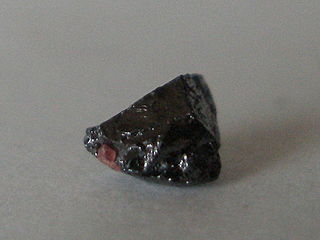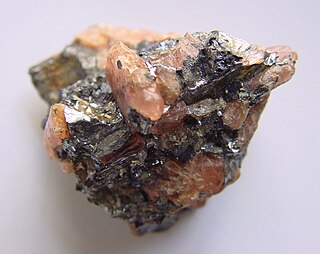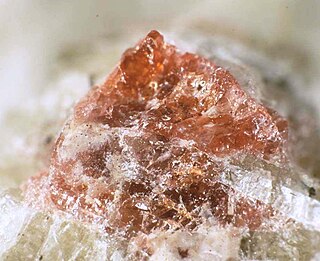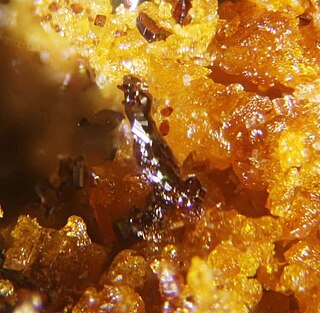Related Research Articles

The pyroxenes are a group of important rock-forming inosilicate minerals found in many igneous and metamorphic rocks. Pyroxenes have the general formula XY(Si,Al)2O6, where X represents calcium (Ca), sodium (Na), iron or magnesium (Mg) and more rarely zinc, manganese or lithium, and Y represents ions of smaller size, such as chromium (Cr), aluminium (Al), magnesium (Mg), cobalt (Co), manganese (Mn), scandium (Sc), titanium (Ti), vanadium (V) or even iron. Although aluminium substitutes extensively for silicon in silicates such as feldspars and amphiboles, the substitution occurs only to a limited extent in most pyroxenes. They share a common structure consisting of single chains of silica tetrahedra. Pyroxenes that crystallize in the monoclinic system are known as clinopyroxenes and those that crystallize in the orthorhombic system are known as orthopyroxenes.

Armalcolite is a titanium-rich mineral with the chemical formula (Mg,Fe2+)Ti2O5. It was first found at Tranquility Base on the Moon in 1969 during the Apollo 11 mission, and is named for Armstrong, Aldrin and Collins, the three Apollo 11 astronauts. Together with tranquillityite and pyroxferroite, it is one of three new minerals that were discovered on the Moon. Armalcolite was later identified at various locations on Earth and has been synthesized in the laboratory. (Tranquillityite and pyroxferroite were also later found at various locations on Earth). The synthesis requires low pressures, high temperatures and rapid quenching from about 1,000 °C to the ambient temperature. Armalcolite breaks down to a mixture of magnesium-rich ilmenite and rutile at temperatures below 1,000 °C, but the conversion slows down with cooling. Because of this quenching requirement, armalcolite is relatively rare and is usually found in association with ilmenite and rutile, among other minerals.

Forsterite (Mg2SiO4; commonly abbreviated as Fo; also known as white olivine) is the magnesium-rich end-member of the olivine solid solution series. It is isomorphous with the iron-rich end-member, fayalite. Forsterite crystallizes in the orthorhombic system (space group Pbnm) with cell parameters a 4.75 Å (0.475 nm), b 10.20 Å (1.020 nm) and c 5.98 Å (0.598 nm).
Diallage is an inosilicate, meaning it is a chain silicate, and is a part of the pyroxene group. Diallage is a junction between augite and diopside, just like fassaite. It was named in 1801 by René Just Haüy. Its name derives from the Greek word diallaghé, as its composition differs from that of the other minerals in the pyroxene group. It is a fairly common mineral, and is cheap.

Hedenbergite, CaFeSi2O6, is the iron rich end member of the pyroxene group having a monoclinic crystal system. The mineral is extremely rarely found as a pure substance, and usually has to be synthesized in a lab. It was named in 1819 after M.A. Ludwig Hedenberg, who was the first to define hedenbergite as a mineral. Contact metamorphic rocks high in iron are the primary geologic setting for hedenbergite. This mineral is unique because it can be found in chondrites and skarns (calc–silicate metamorphic rocks). Since it is a member of the pyroxene family, there is a great deal of interest in its importance to general geologic processes.

Fassaite is a variety of augite with a very low iron content, Ca(Mg,Fe,Al)(Si,Al)2O6. It is named after the Fassa Valley, Italy.

Gmelinite-Na is one of the rarer zeolites but the most common member of the gmelinite series, gmelinite-Ca, gmelinite-K and gmelinite-Na. It is closely related to the very similar mineral chabazite. Gmelinite was named as a single species in 1825 after Christian Gottlob Gmelin (1792–1860) professor of chemistry and mineralogist from Tübingen, Germany, and in 1997 it was raised to the status of a series.
Gmelinite-Na has been synthesised from Na-bearing aluminosilicate gels. The naturally occurring mineral forms striking crystals, shallow, six sided double pyramids, which can be colorless, white, pale yellow, greenish, orange, pink, and red. They have been compared to an angular flying saucer.

Melilite refers to a mineral of the melilite group. Minerals of the group are solid solutions of several endmembers, the most important of which are gehlenite and åkermanite. A generalized formula for common melilite is (Ca,Na)2(Al,Mg,Fe2+)[(Al,Si)SiO7]. Discovered in 1793 near Rome, it has a yellowish, greenish-brown color. The name derives from the Greek words meli (μέλι) "honey" and lithos (λίθους) "stone".The name refers to a group of minerals (melilite group) with chemically similar composition, nearly always minerals in åkermanite-gehlenite series.

Pigeonite is a mineral in the clinopyroxene subgroup of the pyroxene group. It has a general formula of (Ca,Mg,Fe)(Mg,Fe)Si2O6. The calcium cation fraction can vary from 5% to 25%, with iron and magnesium making up the rest of the cations.

Changbaiite (PbNb2O6) is a member of the oxide mineral class in which the mineral contains oxygen which is grouped along with one or two metal ion. Changbaiite is classified as a multiple Oxide XY2O6 and it generally has an ionic bond. Furthermore, it is also orthorhombic at a temperature of 25 °C and it changes to orthorhombic-tetragonal at 570 °C.

Bustamite is a calcium manganese inosilicate (chain silicate) and a member of the wollastonite group. Magnesium, zinc and iron are common impurities substituting for manganese. Bustamite is the high-temperature polymorph of CaMnSi2O6 and johannsenite is the low temperature polymorph. The inversion takes place at 830 °C (1,530 °F), but may be very slow.
Bustamite could be confused with light-colored rhodonite or pyroxmangite, but both these minerals are biaxial (+) whereas bustamite is biaxial (−).
Panguite is a type of titanium oxide mineral first discovered as an inclusion within the Allende meteorite, and first described in 2012.
Kangite is an exceedingly rare scandium mineral, a natural form of impure scandium oxide (Sc2O3), with the formula (Sc,Ti,Al,Zr,Mg,Ca,□)2O3. It crystallizes in the cubic crystal system diploidal class. In terms of chemistry it scandium-analogue of tistarite. Both kangite and tistarite were discovered in the Allende meteorite.
Mogovidite is a very rare mineral of the eudialyte group, with formula Na9(Ca,Na)6Ca6(Fe3+,Fe2+)2Zr3[]Si(Si9O27)2(Si3O9)2(CO3)(OH,H2O)4. The formula given is based on the original one but extended to show the presence of cyclic silicate groups. It is similar to feklichevite, differing from it in the presence of essential vacancies and carbonate group. Another specific feature is the dominance of ferric iron – a feature shared with other eudialyte-group members, including feklichevite, fengchengite, golyshevite and ikranite. Similarly to golyshevite, it is calcium-dominant, however on three sites: M(1), N(3) and N(4). It has a molecular mass of 3,066.24 gm.

Raslakite is a rare mineral of the eudialyte group with the chemical formula Na15Ca3Fe3(Na,Zr)3Zr3(Si,Nb)SiO(Si9O27)2(Si3O9)2(OH,H2O)3(Cl,OH). This formula is based on the original one, and is extended to show the presence of cyclic silicate groups. The additional silicon and oxygen shown in separation from the cyclic groups are in fact connected with two 9-fold rings. The mineral has lowered symmetry, similarly to some other eudialyte-group members: aqualite, labyrinthite, oneillite and voronkovite. The specific feature of raslakite is, among others, the presence of sodium and zirconium at the M2 site. Raslakite was named after Raslak Cirques located nearby the type locality.
Davisite is an exceedingly rare mineral of the pyroxene group, with formula CaScAlSiO6. It is the scandium-dominant member. It stands for scandium-analogue of other pyroxene-group members, esseneite, grossmanite and kushiroite. Davisite is one of scarce minerals containing essential scandium.
Tistarite is an exceedingly rare mineral with the formula Ti2O3, thus being the natural analogue of titanium(III) oxide. In terms of chemistry it is the titanium-analogue of hematite, corundum, eskolaite, and karelianite. Other minerals with the general formula A2O3 are arsenolite, avicennite, claudetite, bismite, bixbyite, kangite, sphaerobismoite, yttriaite-(Y) and valentinite. Tistarite and grossmanite – both found in the famous Allende meteorite (so is kangite) – are the only currently known minerals with trivalent titanium. Titanium in minerals is almost exclusively tetravalent. The only known terrestrial occurrence of tistarite was found during minerals exploration by Shefa Yamim Ltd. in the upper mantle beneath Mount Carmel, Israel.
Yttriaite-(Y) is an exceedingly rare mineral, a natural form of yttrium oxide, Y2O3. In terms of chemistry it is yttrium-analogue of kangite, arsenolite, avicennite and senarmontite (isometric minerals). Other minerals with the general formula A2O3 include corundum, bismite, bixbyite, eskolaite, hematite, karelianite, sphaerobismoite, tistarite, and valentinite. Yttriaite-(Y) forms tiny inclusions in native tungsten.

Esseneite is a relative rare mineral of the pyroxene group, with formula CaFeAlSiO6. It is the ferric-iron-dominant member. Esseneite is an iron-analogue of other pyroxene-group members, davisite, grossmanite, and kushiroite. It is a metamorphic mineral forming in pyrometamorphic rocks called paralavas, which are formed due to fusing on sedimentary rocks usually in result of coal fires. Esseneite is found in both natural and anthropogenic coal-fire sites.
Kushiroite is a rare mineral of the pyroxene group, with formula CaAlAlSiO6. It is the fully aluminian member. The formula of kushiroite corresponds to the molecule (or component) known as Calcium-Tschermak (Ca-Tschermak), which dominates in the composition of kushiroite. Kushiroite is an aluminium-analogue of other pyroxene-group members, davisite, esseneite, and grossmanite. It was found in a chondrite meteorite within refractory inclusions.
References
- 1 2 Mindat, Grossmanite, http://www.mindat.org/min-39426.html
- ↑ Ma, C., and Rossmann, G.R., 2009: Grossmanite, CaTi3+AlSiO6, a new pyroxene from the Allende meteorite. American Mineralogist 94(10), 1491–1494
- ↑ Mindat, Tistarite, http://www.mindat.org/min-38695.html